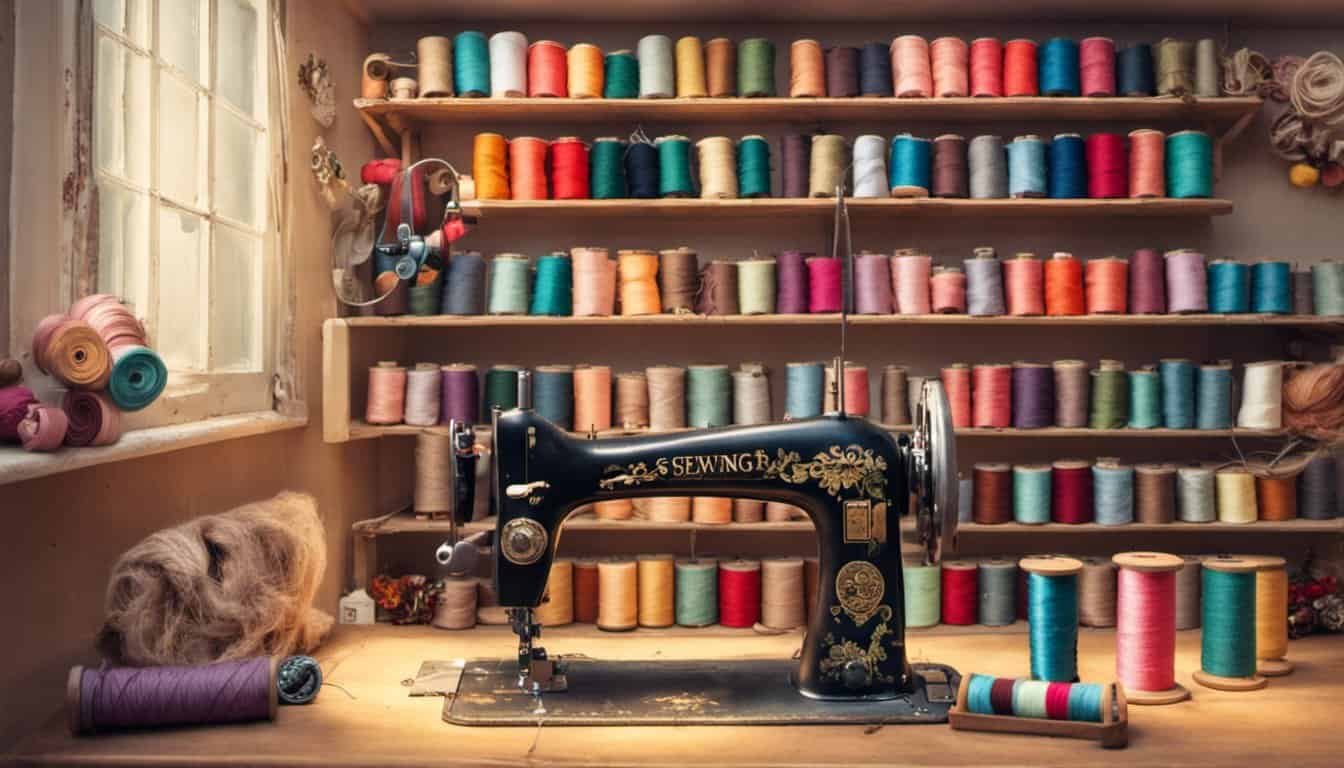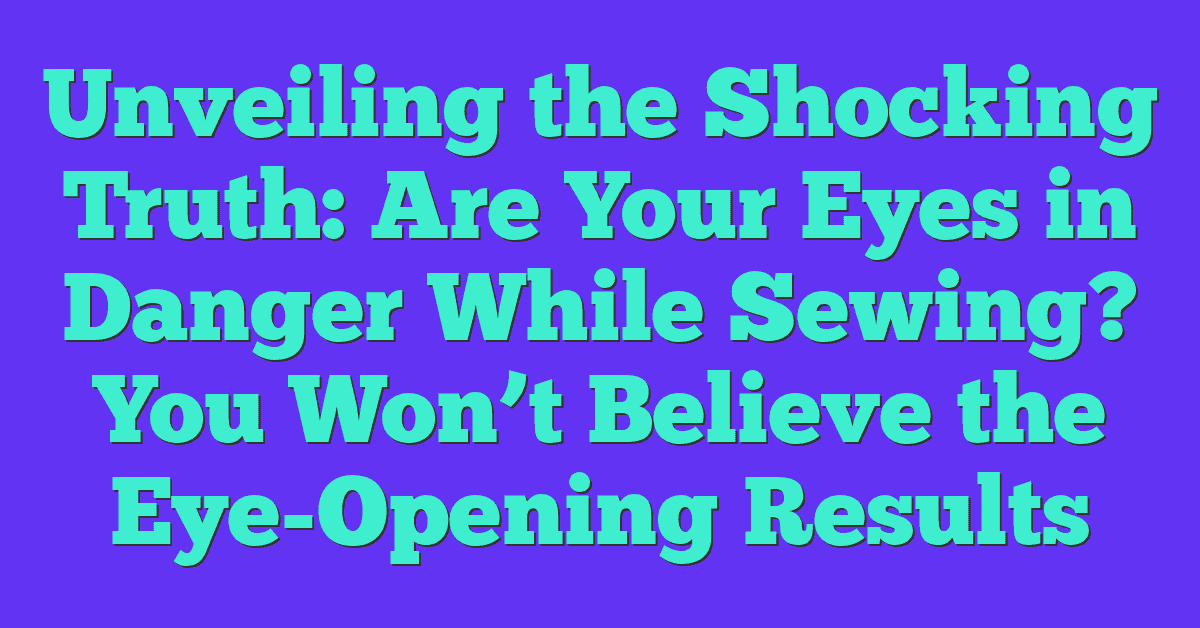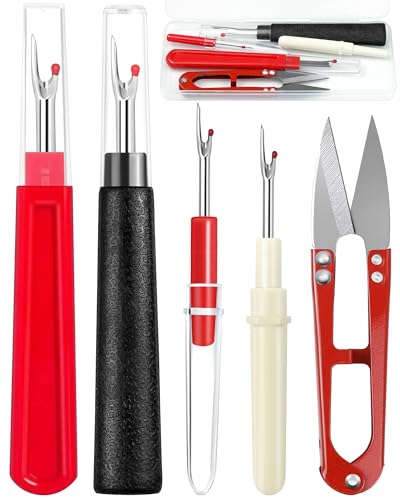Are you an avid sewer? Do you spend countless hours hunched over your sewing machine, creating beautiful garments and crafts? While sewing can be a rewarding and creative hobby, have you ever wondered if it’s bad for your eyes? In this article, we’ll explore the potential effects of sewing on your eyesight and provide some tips to help you protect your vision while pursuing your passion.
If you’re like many sewers, you may find yourself squinting or straining your eyes to see those tiny stitches or intricate details. The prolonged focus on small, detailed work can put a strain on your eyes, leading to eye fatigue and discomfort. But don’t worry, there are steps you can take to minimize the impact on your vision. From proper lighting to taking regular breaks, we’ll share some practical strategies to help you maintain healthy eyes while indulging in your sewing projects.
While sewing may not be inherently bad for your eyes, it’s essential to be aware of the potential risks and take proactive measures to protect your vision. Our eyes are precious, and by implementing a few simple habits and precautions, you can continue to enjoy the art of sewing while keeping your eyes healthy and happy. So, let’s dive in and discover how you can safeguard your eyesight while pursuing your favorite pastime.
The Impact of Sewing on Your Eyesight
As a passionate sewer and craft enthusiast, it’s important to understand the potential impact that sewing can have on your eyesight. Spending long hours focused on detailed stitching or embroidery projects can put strain on your eyes, leading to fatigue and discomfort. However, with a few simple habits and precautions, you can minimize these risks and keep your eyes healthy while enjoying your favorite crafts.
1. Use Proper Lighting
One of the most crucial factors in protecting your eyes while sewing is ensuring adequate lighting. Insufficient lighting can cause eye strain, leading to headaches and blurred vision. Make sure to position your work area near a bright, natural light source or invest in a good-quality desk lamp with adjustable lighting settings. Proper lighting will not only make it easier to see your stitches but also reduce the strain on your eyes.
2. Take Regular Breaks
Prolonged periods of focused sewing can strain your eye muscles and contribute to eye fatigue. To prevent this, be mindful of taking regular breaks. Every 20 to 30 minutes, look away from your work and focus on a distant object for a few seconds. This helps to relax your eye muscles and maintain good eye health.
3. Adjust Your Stitching Distance
The distance between your eyes and your sewing project can also impact your eye health. Avoid holding your work too close to your face, as it can cause undue strain. Instead, maintain a comfortable distance that allows you to see your stitches clearly without needing to strain your eyes.
4. Wear Proper Eyewear
If you wear prescription glasses, ensure that your prescription is up to date and suitable for close-up work. Additionally, consider investing in a pair of magnifying glasses or a magnifying lens attachment for your sewing machine. These aids can reduce eye strain by allowing you to see your work more clearly.
Factors that Can Contribute to Eye Strain While Sewing
When you spend hours engrossed in a sewing project, it’s easy to forget about the strain it may place on your eyes. However, it’s important to be aware of the factors that can contribute to eye strain and take steps to minimize their impact. Here are a few things to consider:
Insufficient Lighting
Inadequate lighting is a common culprit when it comes to eye strain while sewing. When the lighting in your workspace is poor, your eyes have to work harder to focus on the stitches, which can lead to discomfort and fatigue. To combat this, ensure that you have adequate lighting in your sewing room, preferably in the form of natural light or a bright, adjustable lamp. Proper lighting will not only reduce strain on your eyes but also improve your overall stitching accuracy.
Prolonged Eye Focus
Focusing on fine details for extended periods can exhaust your eyes. Prolonged eye focus on your needle and fabric can cause strain and even headaches. Avoid continuously focusing on close objects by periodically shifting your gaze and looking at objects in the distance. Give your eyes a break by incorporating regular eye exercises into your sewing routine, such as focusing on a distant object for 20 seconds every 20 minutes.
Uncomfortable Sewing Position
Sewing in an uncomfortable position can lead to not only physical strain but also eye strain. When your body is tense or your posture is not aligned correctly, your eyes are affected as well. Make sure you have a comfortable and ergonomic sewing setup that allows you to maintain a relaxed posture and position your work at eye level. Invest in a comfortable chair, adjust your sewing machine height, and use supportive cushions or pillows, if needed.
Inadequate Eye Protection
Your eyes can be vulnerable to dust, debris, and potential needle accidents while sewing. Protecting your eyes with safety glasses or goggles is essential to prevent injuries and reduce strain. It’s also a good idea to wear prescription or anti-glare glasses, if necessary, to optimize your vision while sewing.
By being mindful of these factors and implementing some simple adjustments, you can minimize eye strain while pursuing your sewing projects. Remember to keep your workspace well-lit, take regular breaks to rest your eyes, maintain a comfortable sewing position, and protect your eyes with appropriate eyewear. With these habits in place

The Importance of Proper Lighting and Ergonomics in Sewing
When it comes to sewing, embroidery, knitting, and other crafts, it’s important to take care of your eyes. One of the key factors that can contribute to eye strain and discomfort is insufficient lighting. Sewing under dim or inadequate lighting can make it challenging to see the details of your work, leading to eye fatigue. Therefore, proper lighting is crucial to help protect your eyes and make your sewing experience more enjoyable.
To ensure adequate lighting in your sewing room, position your work area near a window or use natural daylight bulbs. Natural light is the best for sewing as it provides clear visibility and helps reduce eye strain. Alternatively, consider using task lighting with adjustable and dimmable features. This allows you to customize the brightness level to suit your needs, minimizing eye strain.
In addition to lighting, maintaining proper posture and ergonomics while sewing is essential. Sitting in an uncomfortable position for an extended period can strain your back, neck, and yes, even your eyes. Make sure your sewing table and chair are at the correct height. Your arms should be relaxed, and your elbows should be at a comfortable 90-degree angle. Keep your feet flat on the floor or use a footrest to support them. Avoid slouching and try to maintain a straight back.
Taking regular breaks and doing eye exercises during your sewing sessions can help alleviate eye strain. Every 20 minutes, take a break and focus on an object in the distance for 20 seconds. This helps relax the eye muscles that have been working hard to focus on close-up sewing tasks. Additionally, you can perform simple eye exercises such as blinking, rolling your eyes, and looking side to side to further relieve eye strain.
Remember, your eyes are precious, and by implementing these practices, you can safeguard your vision while indulging in your favorite crafts. Proper lighting, comfortable ergonomics, and regular eye exercises contribute to a healthier sewing experience. So, take care of your eyes, and keep creating beautiful projects with joy and ease.
Tips for Preventing Eye Strain During Sewing
« Discover the Ultimate Secret to Easily Thread Your Sewing Machine Needles like a Pro – Find the Perfect Needle Threader Now
Shocking Truths: Can Sewing Really Cause Arthritis? Discover Expert Tips to Protect Your Joints Now »
When it comes to indulging in your favorite crafts like sewing, embroidery, knitting, or any other creative endeavor, it’s important to take care of your eyes. Spending long hours focusing on detailed stitches and patterns can lead to eye strain and discomfort. But fear not! With a few simple tips, you can minimize the impact on your vision and enjoy your craft without any worries.
1. Ensure Proper Lighting
Proper lighting is crucial when it comes to protecting your eyes and making your sewing experience more enjoyable. Position your work area near a window to take advantage of natural daylight or use bulbs specifically designed to mimic natural light. This will provide clear visibility and reduce eye strain. Avoid working in dimly lit areas as it can put unnecessary stress on your eyes.
2. Maintain a Comfortable Sewing Position
Maintaining proper posture and ergonomics is another key factor in preventing eye strain. Make sure your sewing table and chair are at the correct height to avoid straining your neck and back. Sit up straight and position your work at a comfortable distance from your eyes. Avoid slouching or leaning in too close to your project, as this can cause unnecessary eye fatigue.
3. Take Regular Breaks and Do Eye Exercises
One of the most effective ways to prevent eye strain is by taking frequent breaks. Every 20-30 minutes, look away from your project and focus on a distant object for a few seconds. This helps relax the muscles in your eyes and reduces fatigue. Additionally, try doing simple eye exercises like rolling your eyes in circles or blinking rapidly to keep your eye muscles active and refreshed.
4. Use Adequate Eye Protection
Last but not least, consider using safety glasses or goggles to protect your eyes while sewing. These can shield your eyes from any potential flying fabric particles or needle accidents. Opt for safety glasses that fit comfortably and provide proper coverage to ensure maximum safety.
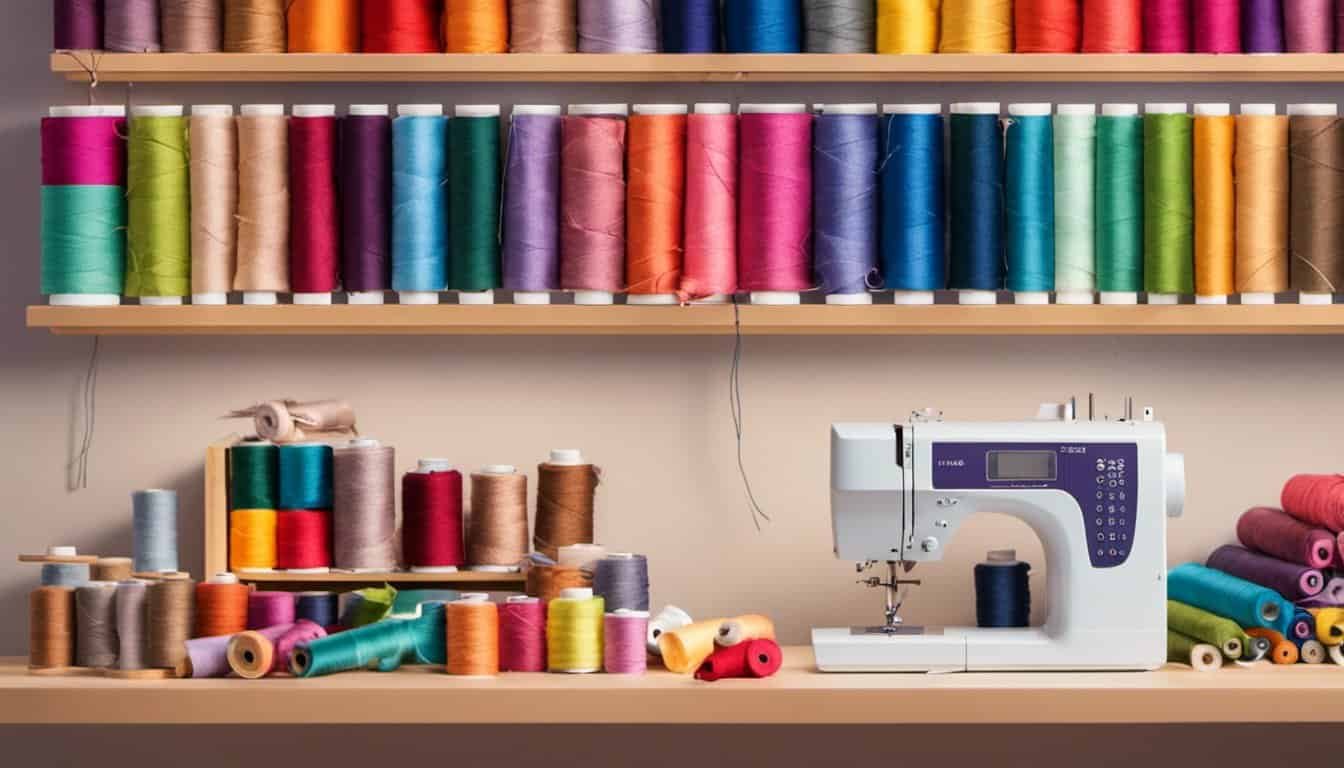
When to Seek Professional Help for Eye-Related Issues
As an expert in all things sewing, embroidery, knitting, and crafts in general, it’s important to address the issue of eye-related problems that may arise from these activities. While sewing itself is not inherently bad for your eyes, it’s essential to be aware of the potential risks and know when to seek professional help. Here are some situations where it’s important to reach out to an eye care specialist:
Persistent Eye Strain and Discomfort
If you experience persistent eye strain, discomfort, or a feeling of dryness even after taking regular breaks and implementing proper lighting, it’s essential to seek professional help. These symptoms could indicate an underlying issue that requires professional examination, diagnosis, and treatment.
Blurred or Double Vision
Blurry or double vision while sewing or engaging in other crafts could be a sign of an underlying condition that needs attention. While occasional blurry vision may be due to temporary eye fatigue, consistent or worsening symptoms should not be ignored. A comprehensive eye examination by a professional can help identify the root cause.
Eye Pain or Headaches
If you frequently experience eye pain or headaches during or after your crafting sessions, it’s important to consult an eye care specialist. These symptoms could be a sign of eye strain or a potential underlying eye condition. Getting professional advice can help identify the cause and provide appropriate treatment options.
Changes in Color Vision
If you notice sudden or gradual changes in your color vision while engaged in sewing or other crafts, it’s important to seek professional help. Changes in color perception could be a symptom of various eye conditions, including color vision deficiency or other color-related abnormalities.
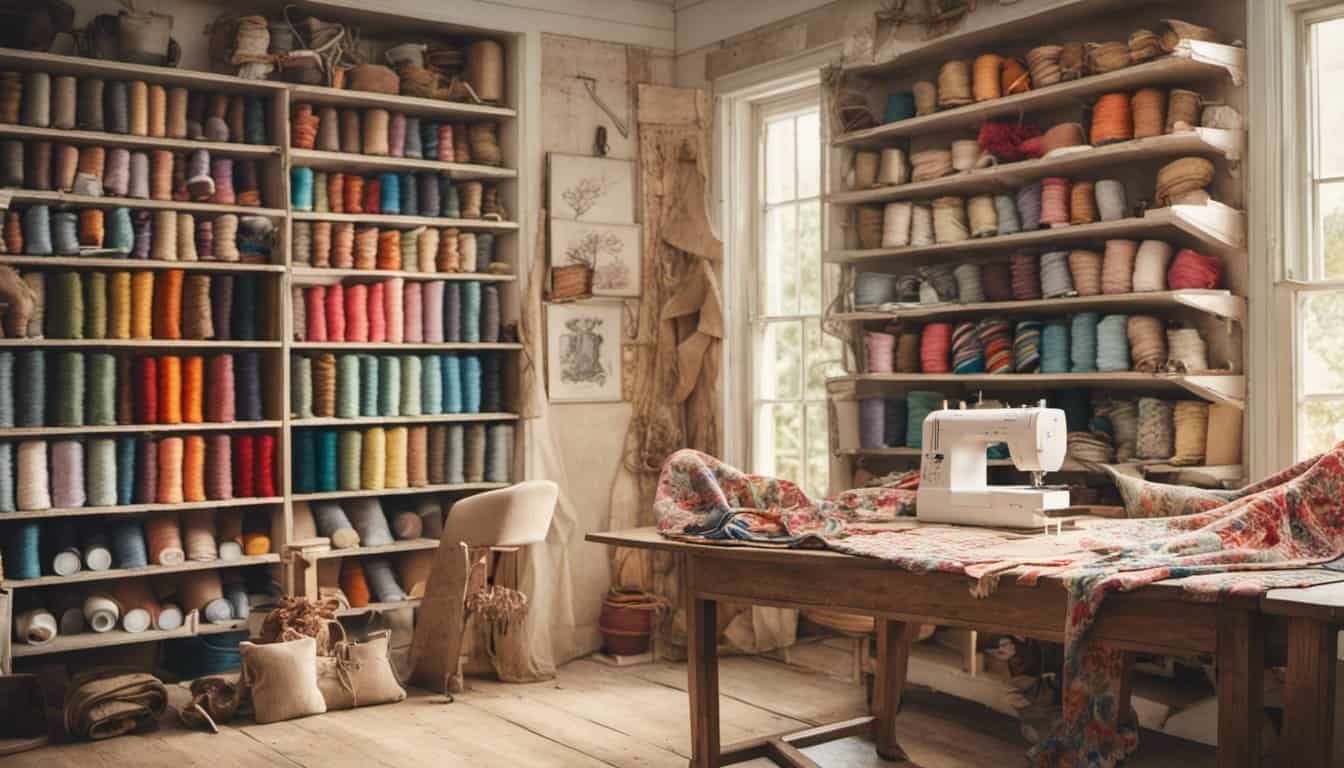
Remember, it’s better to be safe than sorry when it comes to your vision. Seeking professional help in a timely manner can help prevent or manage potential eye-related issues and ensure that you can continue enjoying your beloved crafts for years to come.
Conclusion
To protect your eyes while sewing, it’s important to be mindful of the factors that can contribute to eye strain. Insufficient lighting, prolonged eye focus, uncomfortable sewing position, and inadequate eye protection can all take a toll on your vision.
To minimize the impact on your eyes, make sure you have proper lighting in your sewing room. Take regular breaks and do eye exercises to give your eyes a rest. Maintain a comfortable sewing position to avoid unnecessary strain. And don’t forget to protect your eyes with safety glasses or goggles.
If you experience persistent eye strain or discomfort, blurred or double vision, eye pain or headaches, or changes in color vision, it’s crucial to seek professional help. A professional examination can identify any underlying issues and provide appropriate treatment options.
Remember, taking care of your eyes is essential for your overall well-being. By following these tips and seeking professional advice when needed, you can continue to enjoy sewing while keeping your eyes healthy and comfortable. Happy sewing!
